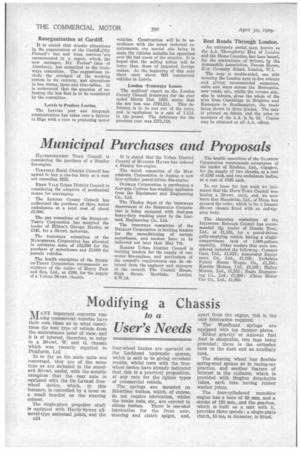Modifying a Chassis
Page 54

If you've noticed an error in this article please click here to report it so we can fix it.
to a
User's Needs
MANY important concerns running commercial vehicles have their own ideas as to what constitutes the best type of vehicle from the maintenance point of view, and it is of interest, therefore, to refer to a 30-cwt. W. and G. chassis which was recently supplied to Pickfords, Ltd.
In so far as the main units are concerned, they are of the same type as are included in the standard 30-cwt. model, with the notable exception that the rear axle is equipped with the De Lavaud freewheel device, which, in this instance, Is controlled by a lever on a small bracket on the steering column.
The single-piece propeller shaft is equipped with Hardy-Spicer allmetal-type universal joints, and the c24 four-wheel brakes are operated on the Lockheed hydraulic system, which is said to be giving excellent results, whilst tests with the freewheel device have already indicated that this is a practical proposition, at any rate for the lighter types of commercial vehicle.
The springs are mounted on Silentbloc bushes, which, of course, do not require lubrication, whilst the brake rods, etc., are carried in oilless bushes. There is one-shot lubrication for the front axle, steering and clutch spigot, and, apart from the engine, this is the only lubrication required.
The Woodhead ' springs are equipped with top damper plates. Hither gravity 'or Autovac fuel feed is obtainable, two taps being provided; there is the orthodox tank on the dash and an auxiliary tank.
The steering wheel has flexible spring-steel spokes as in racing-car practice, and another feature of interest is the radiator, which is provided with Hughes detachable tubes, each tube having rubber washer joints.
The four-cylindered monobloc engine has a bore of 89 mm. and a stroke of 120 ram., and the gearbox, which is built as a unit with it, provides three speeds; a single-plate clutch, 10 ins, in diameter, is fitted.




























































































































